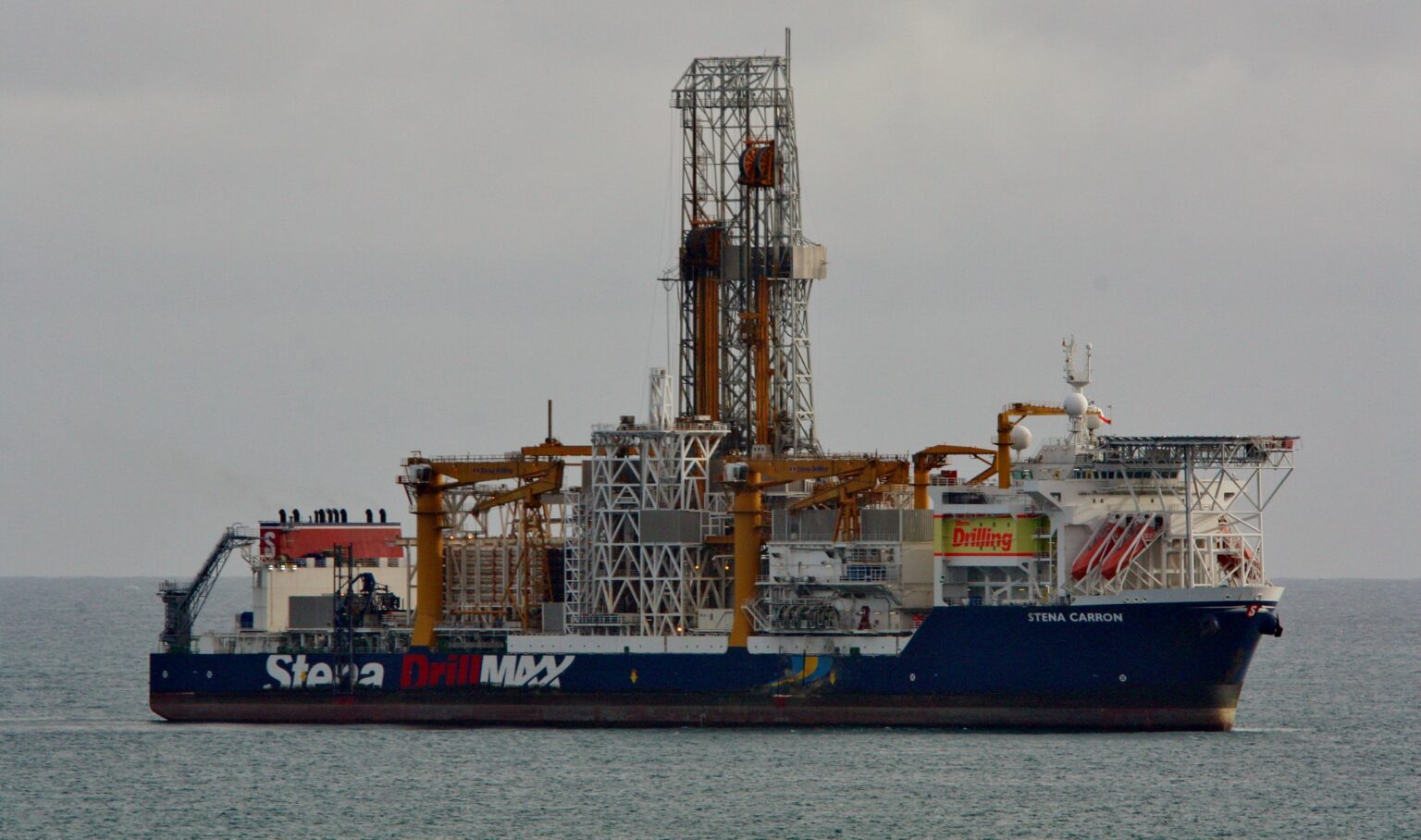About 100 miles off the coast of Guyana, along the northern edge of South America, the drillship Stena Carron spent Saturday, June 5 drilling a new exploratory well on behalf of ExxonMobil. The drilling takes aim at a 9 billion-barrel oilfield recently discovered in the waters off Guyana. Exxon is now putting Guyana at the heart of its plans to press on hunting for new fossil fuel supplies despite the climate crisis.
Meanwhile, much of Guyana itself was underwater following heavy rains that unleashed historic flooding. Over 25,000 households — in a small country with just over 200,000 homes — have been inundated.
“President Irfaan Ali on Saturday said that the flooding currently occurring across Guyana is one of the worst disasters the country has ever faced and projected that it will take some time for the country [to] recover once the situation has abated,” one local newspaper wrote, adding that the remarks by Guyana’s president were made at the opening of a port project newly built to support more oil drilling.
Parts of low-lying Guyana experience flooding every year during the rainy season, but local reporters say that this year’s heavy rains were met with rising rivers due to storms further inland — and left residents, even of a nation whose name translates to “land of water,” stunned.
"President Irfaan Ali on Saturday said that the flooding currently occurring across Guyana is one of the worst disasters the country has ever faced and projected that it will take some time for the country recover once the situation has abated."https://t.co/p1E87o95nQ pic.twitter.com/ZInlFbwAzB
— cecaribbean (@cecaribbean) June 8, 2021
After a dismal financial performance in 2020, ExxonMobil plans to rapidly ramp up oil and gas drilling off the coast of the former British colony near the outer edges of the Caribbean Sea. Those plans would make the rainforest-covered nation, currently a carbon sink, home to one of ExxonMobil’s largest oil developments — and potentially more important to the company’s future fossil fuel production than even Texas’ prolific Permian basin.
Opponents of the oil giant’s plans in Guyana have warned that those ambitions are dangerously out of touch with the times — and completely incompatible with a world where climate change is kept below 1.5 degrees C.
“Double the Risks”
ExxonMobil says it’s made 18 oil discoveries in Guyana since 2015 — the same year the Paris Agreement was adopted — and the company started production in earnest in December 2019. In April, it estimated that the region holds roughly 9 billion recoverable oil-equivalent barrels of fossil fuels.
Meanwhile, the company’s own investors have grown so alarmed over Exxon’s blinders-on approach to climate change and the energy transition that, in a May shareholder meeting, they voted to eject three of the corporation’s current directors and replace them with directors who’ve publicly criticized Exxon’s current leadership for pushing fossil fuel strategies that run “directly counter to the goals of the Paris Agreement.” The move was spearheaded by a small hedge fund called Engine No. 1.
It’s not clear what role, if any, climate change may have played in Guyana’s ongoing floods. The ongoing tragedy, however, offers something of a preview of the future that environmentalists and human rights advocates fear for the low-lying country where 80 percent of the population lives below sea level and where seawalls are already struggling to hold back the ocean.

On Saturday, Guyana’s government announced that ExxonMobil made a donation of $50,000 to assist thousands of flood victims in the country where Exxon has staked its hopes for a future for oil drilling.
“Guyana is being forced to bear double the risks really,” Nikki Reisch, director of climate and energy for the Center of International Environmental Law (CIEL), an environmental watchdog, told DeSmog, “both the economic and financial risks associated with costly offshore development and with tethering its economy and its future to the oil and gas industry, which is in structural decline, and the high environmental and social risks associated with operations.”
“Severe Financial Distress”
The financial risks are particularly profound for the South American nation where roughly two in five people live below the poverty line of roughly $2,000 a year. The deal that Guyana’s government struck with ExxonMobil for the Stabroek Block offers the nation an $18 million signing bonus, plus just 2 percent royalties (along with a 50 percent profit-sharing clause that only kicks in after most of the oil giant’s exploration and development costs have been recouped).
In fact, observers have pointed to the ways that the deal shifts costs to the government of Guyana, as part of the reason that the so-called “breakeven” price of the cost of a barrel of oil from Guyana is below $30 a barrel.
“Many experts and public hopes point to a future with abundant revenues for the country and its people. The likelihood that abundant revenues will materialize, however, is low,” an October 2020 report by the Institute for Energy Economics and Financial Analysis, an energy analysis nonprofit, concluded, warning that ExxonMobil’s “severe financial distress” poses risks for its business partners. “The contract frontloads revenues to oil interests and backloads revenues to Guyana.”
Guyana’s first royalty check arrived in May, adding $4.9 million to the country’s Natural Resources Fund.
Here's an interesting analysis of Guyana's financial issues and the role of oil revenue.
— Ellen R. Wald Ph.D.🛢 (@EnergzdEconomy) June 3, 2021
Drop in prices from covid & technical issues meant that Guyana didn't make as much revenue as it expected in 2020 & is running a budgetary deficit.https://t.co/iUuia1wVlK
Meanwhile, if the plans laid out in ExxonMobil’s most recent earnings call — made before the Engine No. 1 vote — come to fruition, within five years the company could be pumping 750,000 barrels of oil a day from beneath Guyana’s waters. Meanwhile, management revealed during the same call, it expects to rely less on Texas’ Permian basin, which it projects will be producing a maximum of 700,000 barrels of oil daily by 2025.
“Guyana remains an integral part of our long-term growth plans and as such is a high priority,” Exxon’s CEO Darren Woods said during the call.
Engine No. 1 Impacts Ripple South
The company isn’t the only oil giant pushing into the waters of South America. Total and Apache Corp., for example, have been exploring the coast of neighboring Suriname, though results across what drillers call the “Guyana-Suriname basin” have included a number of dry holes and problematic wells.
But while Exxon and others look to continue exploration in the waters off Guyana’s coast, the International Energy Agency (IEA) now warns that new oil and gas exploration and development is incompatible with a stable climate. “If governments are serious about the climate crisis, there can be no new investments in oil, gas, and coal, from now — from this year,” Fatih Birol, the IEA’s executive director, told The Guardian in May when the IEA’s roadmap for the world’s energy sector was released.
That announcement caused ripples throughout the energy world and called into immediate question oil companies’ ambitions in places like South America.
“ExxonMobil’s plans in Guyana and in the region fly in the face of the conclusions that the IEA is drawing about the need to halt new oil and gas investment and production if the world is to stay below dangerous levels of warming, namely keeping warming below 1.5 degrees at a minimum,” CIEL’s Reisch told DeSmog. “There’s a level of cognitive dissonance, I think, in terms of the investment plans and the way in which Exxon is digging in its heels into drilling for the last drop off of Guyana’s shores” versus the reality of climate change.
Last week, ExxonMobil revealed that its shareholders appear to have voted in not just two but three new members to the company’s board of directors, who were nominated by the hedge fund Engine No. 1. All three have called on the oil giant, which has aggressively moved to maintain and grow its fossil fuel production, to finally start taking the climate-altering nature of its products and operations more seriously.
In other words, ExxonMobil’s CEO now answers, in part, to new bosses — ones who have publicly pushed the oil giant to “alter its fossil-fuel focused strategy and more directly confront growing shareholder concerns about climate change,” in the words of the Wall Street Journal. It’s not yet clear whether the Engine No. 1 directors will spur any meaningful changes inside the oil giant — but the message from Exxon’s investors could hardly be more clear.
“A Carbon Bomb”
Exxon’s Guyana project also faces new challenges in the courts. In May, two Guyanese citizens — a scientist and an Indigenous youth — filed a constitutional challenge to the government’s approvals for ExxonMobil’s plans, arguing that the government breached its legal duties to protect its citizens’ rights to a healthy environment, sustainable development, and the rights of Guyana’s future generations.
ExxonMobil's oil production off the coast of Guyana is affecting the state's duty to provide a safe environment for current and future generations, according to the citizens involved in an ongoing lawsuit in the country. From @anastasiabogota: https://t.co/DiF17hgZy1
— Environmental Justice Foundation (@ejfoundation) June 1, 2021
“Guyana’s petroleum production is a potential 3.87 gigatonne carbon bomb, putting Guyana at the forefront of the fight to save the planet from oil and gas,” Melinda Janki, who leads the plaintiff’s legal team, said in a statement accompanying the lawsuit.
The company has also faced controversy over its use of flaring offshore. In 2020, the Center for International Environmental Law reported that ExxonMobil had already flared, or burned, roughly 9 billion cubic feet of fossil gas, making tiny Guyana one of the world’s top 10 gas-flaring countries. The company faulted equipment failure and faces a fine of roughly $1.3 million from Guyana’s environmental regulators (which one local newspaper wrote is so small a fine that it “will in no way disincentivize the oil giant from flaring.”)
ExxonMobil did not respond to questions from DeSmog.
Sea level rise isn’t the only reason oil development may leave Guyana more exposed to floods and storms. Last month, local authorities said they supported clearing mangrove trees, which protect coastal communities against storms and flooding, in order to pave the way for oil and gas infrastructure, according to local news reports.
Meanwhile, ExxonMobil’s critics at home in the U.S. say that the company’s plans pose risks that extend far beyond the “land of water.”
“When U.S.-based companies are leading the push to extract billions of barrels of oil off the coast of South America, it not only endangers the communities adjacent to those developments,” Reisch said, “but it endangers the whole planet because of the massive emissions that it will unlock.”
Subscribe to our newsletter
Stay up to date with DeSmog news and alerts






